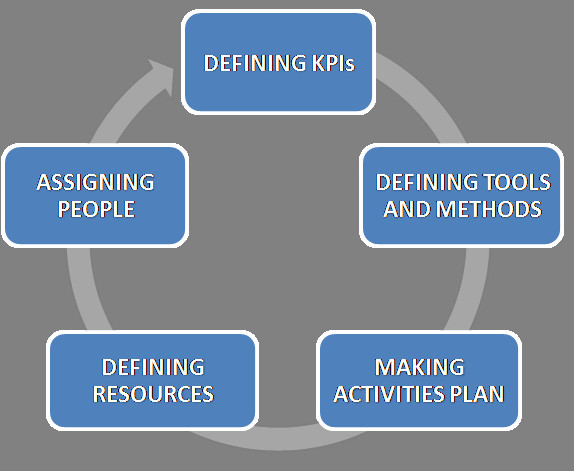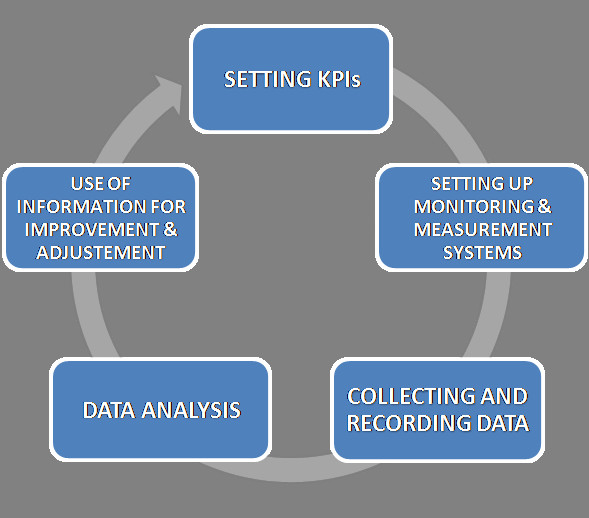Performance management system is a tool for management not for evaluation of performanceUnfortunately, many organizations neglect this part of the cycle and simply do nothing or very little in the period between the target setting and target evaluation. Excuses vary from not having time to do it, to leaving it to the managers to do it in their own way and time etc. In any case they are just excuses. Not monitoring the evaluation will lose the whole meaning of the performance management since then you are not managing the performance throughout the year but only evaluating the end result.
Reasons for Performance Measurement
Aside of the very obvious reason that it is a part of any performance management system and that without it we cannot evaluate the achievement of the targets, there are also other reasons why we need to measure the performance.From company side
- The whole performance management system including the monitoring and measurement process is designed to support the company strategy and achievement of corporate goals
- If we don't monitor the performance of the targets we will not be able to see if we will achieve the company strategy
- Monitoring and measurement gives us valuable inputs for any further development and adjustment of the strategy as well as for the targets of the years to follow
- If we don't measure the performance we won't be able to show if we are doing a good job
- If we don't measure the performance we won't be able to make difference between successful and unsuccessful execution, between outstanding performance and underachievement
- By not making difference between outstanding performance and underachievement we won't be able to recognize and reward the overachievement, nor to correct and develop the underachievement
- This can lead to rewarding and recognizing the wrong people and not rewarding the ones who really deserve it which will ultimately create dissatisfaction and drop of motivation
- The managers who don't measure the performance cannot see where they should improve the work of their teams etc.
Setting Targets and Making Monitoring and Measurement Plan
Performance measurement starts with the target setting! Although many may think that the monitoring and measurement phase starts after the targets are set, it actually starts with the setting of the targets because this is the phase when the KPIs are set and when the measurement methods and tools are foreseen.When setting the goals and the specific targets (KPIs) for each goal it is important to foresee how the achievement of the target will be monitored and measured. If a certain target cannot be measured, or is very difficult to measure, then such target shouldn't be set.
The next step in the monitoring and measurement process would be to define a monitoring and measurement plan. But let’s go step by step.
What is Monitoring?
Technically performance monitoring is systematical gathering and analysis of information in parallel with the accomplishment of the task or job. In other words it means that as the work is being done, someone has the task to gather information and make the necessary analysis from which we can get a clear picture on the actual performance and make necessary decisions. This means that in order to be able to monitor the performance first we need to know what are the goal and the KPI for that goal. Then we need to establish monitoring and measurement tools and methods. At the end we need to foresee the needed resources as well as the people that will be assigned to monitor the performance.The goal of the monitoring is to improve the efficiency and effectiveness of the performance through constantly keeping track on the actual performance. It also helps keep performance on the right track.
Planning the Monitoring and Measurement
It is difficult to go back and establish the monitoring and measurement systems, methods and measures once the achievement of a certain target has started. For example, try to measure and evaluate the achievement of a certain task or project without defining a monitoring and evaluation plan prior to the start of that task or project. What will you measure? What will you evaluate? How will you do it? Based on what?It is difficult to go back and establish the monitoring and measurement systems, methods and measures once the achievement of a certain target has startedMonitoring and measurement should be part of the performance management system and should be well planned at the time of target setting. This plan should comprise the following:
1. Defining Key Performance Indicators (KPIs)
KPIs are measurable, traceable and visible signs / indicators that something has been achieved or not. They are an important part of any performance management system because they are what you actually monitor and measure. In order to be measured the KPIs are set at the beginning of the process, i.e. during the target setting so that assigned employees can immediately start with gathering information.
A simple guidance on how to set KPIs is to see if the ones that we have set justify the term Key Performance Indicator. This means that it should be a key contributor to the success of the goal. The contributors are key only when they make significant impact on the goal. The indicator should be a performance measure that can be measured, quantified, adjusted and controlled. The measure must be controllable in order to be able to adjust and improve the performance if needed. And finally it should be an indicator, a pointer of what we have defined to be successful accomplishment of the specific goal.
Some examples of KPIs are revenue ($), income ($), market share (%), number of new products on market (number), customer churn (%), employee fluctuation (%), employee satisfaction (index) etc.

2. Defining Tools and Methods for Monitoring, Measuring and Evaluation
Next step after the definition of the KPIs is to define the methods, measures and tools for gathering the necessary information for the analysis. These directly depend on the nature of the goal and the KPI.
For example, information can be gathered from activities reports, meeting notes, financial reports, or by surveys, interviews etc.
3. Defining Activities Plan
Now it's time to define the activities plan and schedule for monitoring. Again it will depend on the nature of the goal and the KPI how often we will need to gather information and make analysis. The achievement of some goals may be measured monthly or quarterly, while other goals may require daily measuring and monitoring.
4. Defining Resources
After the methods and tools have been defined and the activities plan has been set we need to foresee the resources that we'll need to perform the monitoring and measurement. This includes material, financial resources and people.
5. Assigning People
The last step is to assign people who will perform the measurement and monitoring.

Elements of Monitoring
The whole monitoring and measurement process is consisted of the following elements:- Setting KPIs
- Setting up monitoring and measurement systems
- Collecting and recording data
- Data analysis
- Use of information for reporting, improvement and adjustment










No comments:
Post a Comment
Note: Only a member of this blog may post a comment.